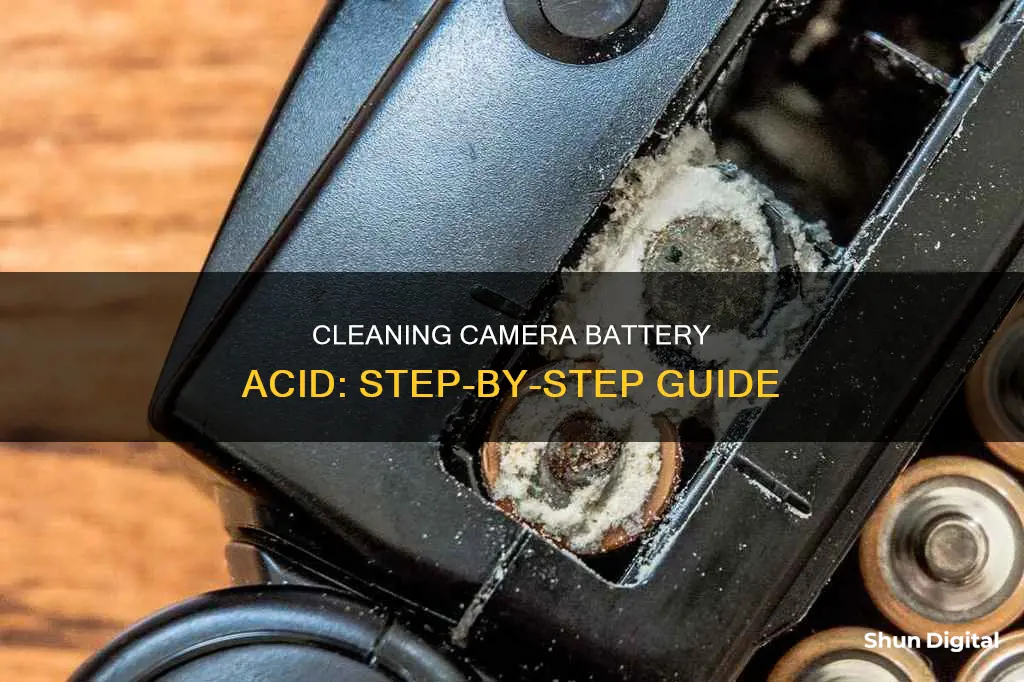
If you've ever opened the battery compartment of your camera to find a crusty, white mess, you're not alone. Battery acid leaks are common, especially if you leave your device unused for long periods. The good news is that you can clean up the mess and restore your camera to working condition. In this guide, we'll walk you through the steps to safely and effectively remove battery acid corrosion from your camera.
| Characteristics | Values |
|---|---|
| Protective gear | Gloves, safety glasses, long-sleeved clothing |
| Clean workspace | Spread newspaper over the surface |
| Clean the compartment | Use cotton swabs with vinegar, lemon juice, or baking soda and water |
| Clean the terminals | Use fine-grit sandpaper or a pencil eraser |
| Dry the compartment | Use a microfiber cloth, blow with compressed gas, or pat gently |
| Clean with alcohol | Use a high concentration of isopropyl alcohol on a Q-tip |
What You'll Learn

Wear protective clothing
When cleaning battery acid from a camera, it is important to wear protective clothing to shield your skin and eyes from the harmful chemicals found in batteries. Here are some detailed instructions to ensure your safety:
Firstly, it is recommended to wear long-sleeved clothing to protect your arms. This creates a barrier between your skin and any corrosive substances you will be handling. Long sleeves can also prevent fibres from falling into the camera's internal components.
Secondly, don safety goggles or glasses to protect your eyes. This is crucial as the chemicals in batteries can cause permanent eye damage if they come into contact with them. Goggles or glasses will also protect your eyes from any debris or cleaning fluids that may splash during the cleaning process.
Thirdly, wear protective gloves. Ordinary rubber gloves, such as those used for household cleaning, are suitable. Gloves will shield your hands from the corrosive chemicals and prevent skin irritation or burns.
Additionally, consider wearing a mask to avoid inhaling any harmful fumes or particles. While this may be considered overkill by some, it can provide an extra layer of protection.
By following these precautions and wearing the appropriate protective clothing, you can help ensure a safe and effective cleaning process when dealing with battery acid in a camera.
Charging the Polaroid Spectra System Camera: A Step-by-Step Guide
You may want to see also

Identify the corrosion
Identifying corrosion in your camera's battery compartment is an essential step before attempting to clean it. Here is a detailed guide to help you identify the corrosion caused by battery acid:
Recognising the Signs of Corrosion
The first step is to open the battery door or compartment of your camera. Use a flashlight to inspect the interior thoroughly. Look for any signs of rust or flaky, white substance encrusted on the battery terminals, contacts, or other areas inside the battery compartment. This white crusty residue is a telltale sign of battery corrosion. It is caused by a build-up of gas and the slow discharge of batteries left in the device for an extended period.
Understanding the Cause of Corrosion
Battery corrosion occurs when the insulating seals of the battery are compromised, allowing the electrolyte solution to leak out. This electrolyte, potassium hydroxide, is an aqueous solution that reacts with carbon dioxide in the air to form potassium carbonate. The resulting substance is the white crystalline powder often seen in corroded batteries.
Safety Precautions
It is important to note that potassium hydroxide is a caustic chemical that can irritate the skin and eyes. Therefore, it is crucial to take safety precautions when inspecting and cleaning corroded batteries. Wear protective gear, such as gloves and safety goggles, to safeguard your skin and eyes from coming into direct contact with the corrosive substances.
Identifying the Type of Battery
Different types of batteries have varying tendencies to leak and corrode. For example, alkaline batteries are prone to leaking, while lithium batteries have a longer shelf life and are less likely to leak. Identifying the type of battery your camera uses can help you understand the potential causes of corrosion and take preventive measures in the future.
Are PTZ Cameras Electrically Charged?
You may want to see also

Use a neutralising agent
To clean battery acid from a camera, you will need to use a neutralising agent. This is because, when left in a device, batteries will continue to slowly discharge, and a build-up of gas will leak out in the form of corrosive battery acid. This acid can burn your skin, harm your eyes, and corrode the delicate wires and chips in your camera.
Firstly, put on some protective gloves and eyewear to avoid any chemical burns. Remove the batteries from your camera and place them in a plastic bag for disposal in the trash. Next, use a cotton swab or a toothbrush to carefully apply a neutralising agent to the affected areas of your camera. You can use a few drops of a mild household acid like white vinegar or lemon juice. You may hear a slight sizzling noise, which is a sign that the neutralising agent is working. For more stubborn corrosion, a toothbrush dipped in vinegar or lemon juice will help to loosen it.
After you have neutralised the acid, carefully dry the area with a cotton swab. Once the area is completely dry, you can scrape away any remaining residue with a paper clip or fine-grit sandpaper. Finally, use a pencil eraser to polish the metal battery terminals.
Charging Multiple Camera Batteries: Efficient Methods to Explore
You may want to see also

Clean with isopropyl alcohol
To clean battery acid from a camera, you can use isopropyl alcohol, also known as 'rubbing alcohol'. This is a safe and effective way to clean electronics without leaving behind moisture and other residue.
First, make sure you are wearing protective gloves and safety goggles to protect your skin and eyes from the harmful chemicals inside batteries. You may also want to wear a mask and long-sleeved clothing to protect yourself from inhaling any particles.
Next, open the battery door of the camera and use a flashlight to identify where the corrosion is. Corrosion usually looks like rust. Apply some isopropyl alcohol to a cotton swab and gently clean the affected areas. You can also try using a Q-tip, which is textured and gentle, and useful for reaching smaller areas.
After removing as much corrosion as possible, you can add a bit of baking soda to the areas. Then, apply some vinegar to a new, clean cotton swab and drip it onto the baking soda. Be careful not to use too much vinegar, as it can destroy the internals of the camera.
Finally, clean the area with a towel and give it another pass with isopropyl alcohol. Let it dry, and gently pat it down. The camera should be dry within a few hours. If you are not satisfied with the result, you can repeat the process.
How to Ensure Your Camera Charges Efficiently While Switched Off
You may want to see also

Dry the camera
Drying the camera is an important step in the battery acid cleaning process. After applying isopropyl alcohol to the affected areas, it is recommended to let the camera dry completely before installing fresh batteries and turning the device back on. This step ensures that any remaining liquid evaporates and helps prevent further corrosion or damage to the camera's internal components.
The drying process can be facilitated by using a microfiber cloth to wipe down the cleaned surfaces. A pencil eraser can also be used to polish the surfaces and remove any residual liquid. For hard-to-reach areas or stubborn debris, compressed gas designed for cleaning electronics can be used to blow away any remaining moisture and fibres.
It is important to be thorough during the drying process and ensure that all internal components, especially those in the battery compartment, are completely dry. This may require leaving the camera to sit for a few hours or even overnight to ensure that all moisture has evaporated.
Additionally, it is worth noting that proper storage of the camera after the cleaning process is crucial. Storing the camera in a cool, dry place and ensuring that the battery compartment remains clean and dry will help prevent future corrosion and ensure the longevity of the device.
By following these steps and allowing adequate drying time, you can help ensure that your camera is fully restored and protected from further corrosion.
Cleaning Camera Battery Terminals: A Step-by-Step Guide
You may want to see also
Frequently asked questions
Always wear protective gloves and safety goggles to shield your skin and eyes from the harmful chemicals in batteries. It is also recommended to wear long-sleeved clothing and perform the task on a protected work surface.
White vinegar, lemon juice, or a mixture of water and baking soda can be applied with cotton swabs, foam Q-tips, or a toothbrush to neutralize the battery discharge. For heavier corrosion, fine-grit sandpaper or a small flathead screwdriver can be used gently.
Using a cotton swab or foam Q-tip, gently dab or drip the cleaning solution onto the corroded areas. For areas that are harder to reach, such as springs, use a toothbrush or a small, flathead screwdriver.
After removing the corrosion, clean the contacts and battery compartment with isopropyl (rubbing) alcohol to eliminate any residue. Then, dry the camera with a microfiber cloth or towel and let it air dry completely before installing fresh batteries.







